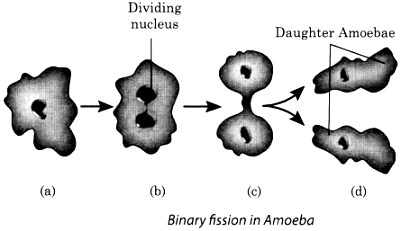NCERT Solutions Class 8 Science Chapter 9 Reproduction in Animals
1. Explain the importance of reproduction in organisms.
Solution:
Importance of reproduction in organisms is as follows
- Reproduction is termed to be a biological process in which organisms give birth to their off springs.
- It helps in maintaining the continuity of a particular race and helps in increasing the population of the species.
- Reproduction is meant for the survival of all living things.
2. Describe the process of fertilisation in human beings.
Solution:
- Fertilization is defined as the process in which there is a fusion of male gamete and female gamete.
- The male gametes or sperms are released from the male reproductive organ called the penis.
- The sperms release and enter the female body through the vagina.
- From the vagina, sperms travel through the fallopian tubes where they meet the eggs.
- From there on, the process of fertilization takes place in the fallopian tube.
- The male gamete cell (sperm) and female gamete cell (egg) fuse together to form a zygote.
- The zygote divides rapidly to form a group of cells called morula, which becomes the embryo after approximately five days. The foetus is present for about eight weeks after the fertilization.
3. Choose the most appropriate answer.
(a) Internal fertilisation occurs
(i) in female body.
(ii) outside female body.
(iii) in male body.
(iv) outside male body.
(b) A tadpole develops into an adult frog by the process of
(i) fertilisation
(ii) metamorphosis
(iii) embedding
(iv) budding
(c) The number of nuclei present in a zygote is
(i) none
(ii) one
(iii) two
(iv) four
Solution:
a) (i) in female body.
b) (ii) metamorphosis
c) (iii) two
4. Indicate whether the following statements are True (T) or False (F).
(a) Oviparous animals give birth to young ones.
(b) Each sperm is a single cell.
(c) External fertilisation takes place in frog.
(d) A new human individual develops from a cell called gamete.
(e) Egg laid after fertilisation is made up of a single cell.
(f) Amoeba reproduces by budding.
(g) Fertilisation is necessary even in asexual reproduction
(h) Binary fission is a method of asexual reproduction.
(i) A zygote is formed as a result of fertilisation.
(j) An embryo is made up of a single cell.
Solution:
a) False
b) True
c) True
d) False
e) True
f) False
g) False
h) True
i) True
j) False
5. Give two differences between a zygote and a foetus.
Solution:
Zygote:
- It is the earliest stage of development
- It is formed by the fusion of male and female gametes
- It is a single cell
- The zygote divides several times to form an embryo
- The zygote normally lasts a week and then develop into its next stage.
Foetus:
- It is the last developmental stage of an organism
- The stage of the embryo that shows all the main recognizable body parts of a mature organism.
- The foetus stage occurs after the embryo stage.
- Foetus mainly undergoes internal development.
6. Define asexual reproduction. Describe two methods of asexual reproduction in animals.
Solution:
In this type of reproduction, the offspring arises from a single organism without the fusion of male and female gametes. It never changes the number of chromosomes.
Binary fission in amoeba
- It is a kind of asexual reproduction in which one cell divides into two halves.
- It is a unicellular organism that has a cell membrane, cell wall and cytoplasm.
- The division of the cell can take place on any plane.
- In this process, the nucleus of the amoeba first divides to form two daughter nuclei by the process called Karyokinesis.
- Finally, the division of the body into two halves having a nucleus respectively takes place.

Budding in hydra
- Organisms such as hydra, use regenerative cells for reproduction in the process of budding.
- The first step is the formation of buds, and it develops as a small outgrowth on the parent’s body.
- As the bud enlarges, it receives the characteristics of the parent organism.
- Once it is developed, it may be detached from the parent body and develop into a new individual.
- In some rare cases, the buds may not be detached forming interconnected buds.
- There are also methods like fragmentation, multiple fission etc.

7. In which female reproductive organ does the embryo get embedded?
Solution:
- In the female reproductive organ, the embryo gets attached to the uterus.
- Once it gets attached, there occurs the formation of body parts like legs, hands, eyes etc.
- The embryo is then called a foetus.
8. What is metamorphosis? Give examples.
Solution:
The transformation of larva into an adult involving sudden and abrupt changes in the body of an animal during the life cycle of an invertebrate or amphibian is called metamorphosis. Example, frog and butterfly.